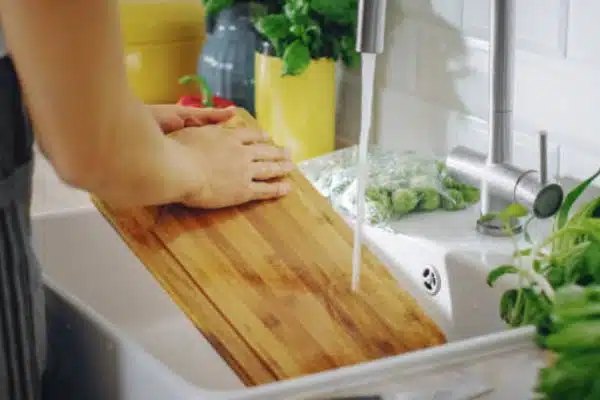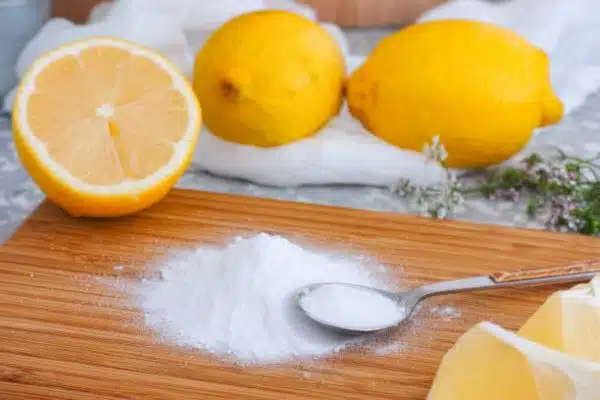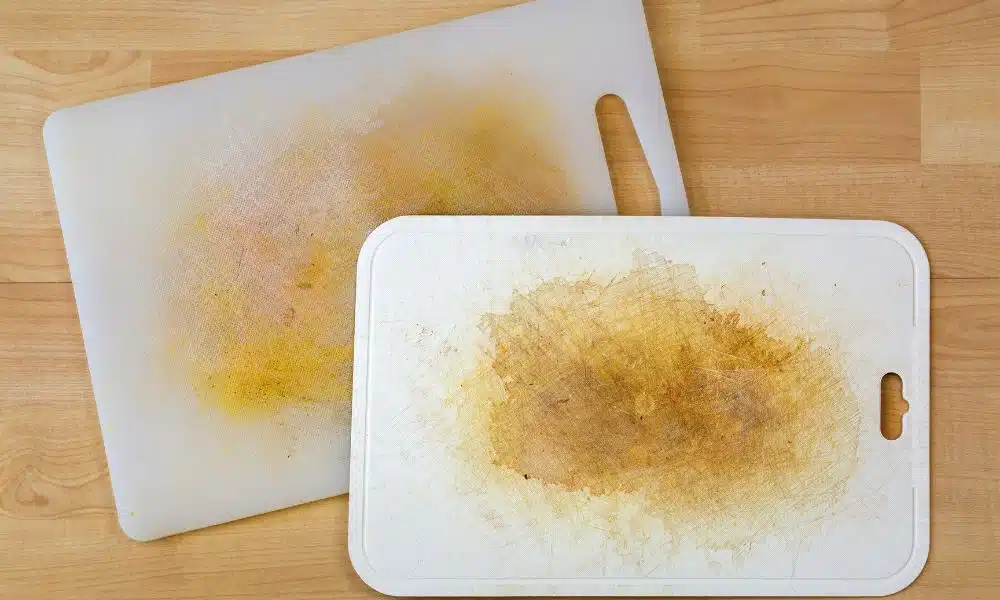Have you ever scrubbed your cutting board, only to find it still smells like garlic—or worse, looks stained from last night’s curry? I’ve been there too. In my kitchen, The cutting board is like An old friend—it’s seen everything from juicy strawberries to stubborn turmeric. Over time, I’ve learned A few tricks on how to remove stains from cutting board surfaces without harsh chemicals. It’s easier than you think, And worth it for your health and peace Of mind. Today, I’ll share what really works—natural, Safe, And beginner-friendly.
What Causes Cutting Board Stains and Smells?
Cutting boards go through a lot. One day, you’re slicing juicy strawberries. Next, you’re chopping garlic or grating turmeric. These bold foods leave behind more than flavour—they leave stains and strong smells.
Turmeric, beets, and berries are common stain-makers. They have deep colours that soak into the board. These pigments are natural, but they cling tightly, especially to wood and scratched plastic.
Wood and plastic absorb stains in different ways. Wood boards are porous. They pull in moisture, colour, and smell. Plastic boards don’t soak things in, but small knife marks trap food and bacteria.
Smells often mean bacteria are hiding in the board. Even if it looks clean, Food bits may be stuck inside. This can lead To bad smells Or even food safety issues.
Step-by-Step: How to Remove Stains from Cutting Board
Over the years, I’ve tried every trick to keep my boards clean. Some worked. Some didn’t. But these simple steps always bring them back to life. Here are surfaces using easy, natural methods.
01. Rinse with Warm Water

Start simple. Run warm water over the board To loosen dirt and oils. This clears the way For your cleaner To do its job. It also softens dry stains, so they’re easier to lift.
02. Scrub with Salt and Lemon
Grab a lemon And cut it in half. Sprinkle coarse salt over the stained area. Then use the lemon like A scrubber, rubbing it in circles. The salt scrubs. The lemon cuts the odour And brightens the board. This works great For surface stains and smells.
03. Apply Baking Soda Paste

For deeper stains, mix one part baking soda with one part water. Make a thick paste and spread it over the stain. Let it sit for 10 minutes. Then scrub with a soft brush or cloth. This pulls out old marks without harming.
04. Rinse and Air-Dry
Rinse well with warm water and dry the board with a clean towel. Stand it up or lay it on its side to air-dry fully. A dry board means no lingering smells or trapped moisture. For meat lovers, check out our guide on the Best Cutting Board For Brisket to find the perfect option for your next barbecue.
How to Clean Cutting Board with Lemon

Sometimes, the best tools are already in your kitchen. Lemon is one of the easiest and safest ways to clean a cutting board. It’s not just for flavor—it’s a natural cleaner, too. Its acid cuts through stains. Its scent clears away odors. It’s simple, fresh, and it works.
Sprinkle Salt
Shake coarse salt over the board. Use enough to cover the stained area. The salt will act as a gentle scrub.
Scrub with a Halved Lemon
Cut a lemon in half. Press it cut-side down onto the salt. Scrub in small circles. Use steady pressure. The juice mixes with the salt to lift stains and kill germs.
Let It Sit for 5 Minutes
After scrubbing, let the lemon and salt mix sit on the board. Give it five minutes to work deeper. This helps with strong smells like garlic or fish.
Rinse and Dry
Rinse the board with warm water. Wipe it dry with a clean towel. Then let it air-dry standing up or on its side.
Bonus: Natural and Safe Cleaning Recipes
Some of the best cleaning tools are already in your kitchen. No need for harsh sprays or bleach. These natural and safe recipes get the job done with simple, trusted ingredients.
Lemon + Salt Scrub
This one’s a classic. Sprinkle coarse salt over the board. Cut a lemon in half and scrub the surface with the cut side. Let it sit for five minutes. Rinse and dry. Great for wood and bamboo.
Baking Soda + Vinegar Paste
Make a paste using 1 tablespoon of baking soda and a splash of white vinegar. Apply to the stain. Let it bubble for a minute or two. Then scrub gently with a sponge. Works well on plastic or light wood.
Hydrogen Peroxide Soak (For Plastic)
Pour 3% hydrogen peroxide over your plastic board. Let it sit for 10 minutes to remove deep odors and stains. Rinse well and dry. Avoid using this on wood—it can dry out the surface.
Important Reminder: Avoid Bleach on Wood Boards
Bleach may seem like a quick fix, but it’s not safe for wood. It breaks down fibers and leaves behind a strong smell. Stick to natural options that clean without damage.
Natural doesn’t mean weak. These gentle cleaners pack A punch—and they’ll keep your kitchen feeling fresh And safe.
Pro Tips to Prevent Future Stains

A clean board starts with good habits. A little care goes a long way—especially that work hard every day. These simple tips will help you stop stains before they start and keep your kitchen safer, too.
Use Separate Boards for Different Foods
Color-coded or not, using one for raw meat and another for veggies is a smart move. Bread deserves its clean surface, too. This cuts down on stains and stops germs from spreading.
Oil Wooden Boards Regularly
Dry wood cracks and absorbs more. Rub in food-grade mineral oil once a week or after deep cleaning. This creates a light barrier that helps block stains and water damage. Your board will last longer and look better.
Rinse and Dry Right Away
After each use, rinse with warm water and wipe dry. Don’t let water or food sit on the surface. Stand it up to air-dry fully. This one step keeps odours and discolouration away.
Final Thoughts
Your cutting board is more than just A surface. It’s part of every meal, every memory, And every bite you serve. Keeping it clean doesn’t take much—but it makes A big difference. A stain-free board means a safer, Fresher kitchen.
The natural methods we’ve covered Are simple, safe, and proven. Whether you reach for lemon, Baking soda, Or a bit of vinegar, You now have the tools to tackle stains without stress.


